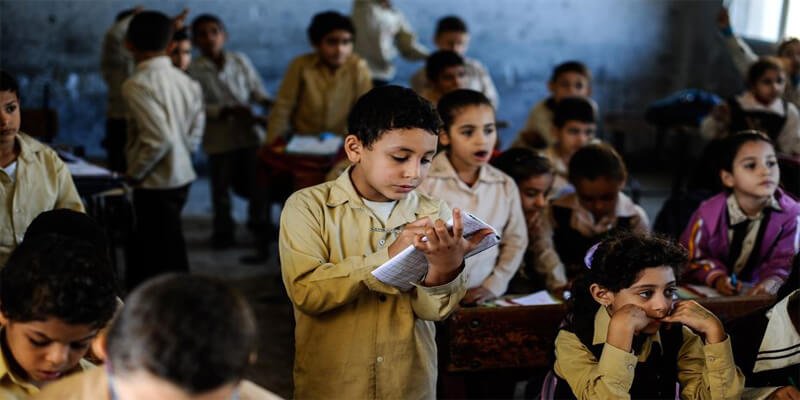
This publication has benefited from the support of the Rosa Luxemburg Foundation. This text may be reproduced in part or in full, provided the source is acknowledged.
In the 18th century, Egypt saw the introduction of modern public schools by Muhammad Ali, who was known as the "enlightened tyrant" for his efforts to spread European enlightenment culture and values in Egypt through a top-down authoritarian approach. However, two centuries later, the term has morphed from a supposedly enlightening concept into an oppressive pattern wielded by the ruling authorities in Egypt. The question that arises now is how this change came about.
To identify the root causes of the decline in public education, we will analyze various key factors such as educational policies, power dynamics, financial allocations, types of education, and their social and economic impacts.
How have the State’s educational policies proceeded?
President Abdel Fattah El-Sissi's educational policies have taken two different approaches. The first focuses on supporting the militarization of education, while the second aims to strengthen local and international investment partnerships to establish large-scale educational institutions. Unfortunately, this is unfolding at a time when the quality of free pre-university and university education provided by the July State is diminishing.
Egypt's pre-university education system has several stages, including kindergarten, compulsory basic education (primary and preparatory), and secondary education. Although secondary education is not mandatory, it is divided into three types: general secondary schools, hotel secondary schools, and technical secondary schools (including agricultural, industrial, and commercial schools). Additionally, Al-Azhar education is available through Al-Azhar schools and institutes. As of 2019, the number of Al-Azhar schools and institutes has reached 65,900.
In Egypt, there are three types of education available: public, private, and international. Public education is further divided into various categories such as free, pilot, national, and religious education schools; special schools for children with special needs; and community education schools. Community education includes various types of schools such as one-classroom schools, community schools, schools for homeless children, girl-friendly schools, and literacy and adult education classes. Private education includes general schools, religious schools, and special schools for children with special needs. Meanwhile, foreign and Egyptian international schools have totaled 805 in 2023.
Egypt’s education system is struggling with a chronic shortage of teachers compared to the growing number of students, not to mention the thousands of teachers who retire every year. In 2021 alone, over 24,000 teachers retired. In response, the authorities have opened temporary contract competitions for teachers and requested volunteer teachers.
For the academic year 2023, there are a total of 49,804 government schools and 10,450 private schools. The number of teachers in pre-university education has reached 699,955 for 25,232,494 students. A considerable percentage of unemployed people are graduates, with 82.2% of them holding intermediate, above-intermediate, or university degrees. Those with higher qualifications, such as master's and doctorates, represent about 36.3% of the total unemployed population.
Egypt's higher education system comprises 176 government and private institutes, as well as research centers that are spread across the Ministry of Higher Education, the Academy of Scientific Research, universities, and other government ministries. The system comprises 92 universities in Egypt, including 28 government-owned, 27 private-owned, and 4 international universities. According to official data, 15 local universities are affiliated with government-run universities, 7 branches of foreign universities situated in the New Administrative Capital, and 10 technological universities[1].
Reality and facts
The state of education in Egypt is marked by two discernable trends. The first trend reflects an upward trajectory, represented by the typically expensive private and international education. The second trend moves on a downward trajectory, represented by free education. Sadly, the available data suggests a deterioration in the quality of free public education.
Based on 2023 statistics, the number of students enrolled in higher education has hit a new high, reaching 3.5 million. The majority of these students, about 2.4 million, are registered in government and Al-Azhar universities, while private universities have enrolled 228,900 students, and post-secondary technical institutes have enrolled 181,400 students. However, despite these impressive numbers, the educational standards have been in decline, affecting the social and economic conditions of the country. The negative impact has resulted in a general decline and increasing unemployment rates. Recent data shows that a considerable percentage of unemployed people are graduates, with 82.2% of them holding intermediate, above-intermediate, university, or higher degrees. Furthermore, those with higher qualifications, such as master's and doctorates, represent about 36.3% of the total unemployed population.
For the academic year 2023, there are a total of 49,804 government schools and 10,450 private schools, according to the official Central Agency for Statistics. The number of teachers in pre-university education has reached 955,699; they teach 25,494,232 students. This represents an increase from the previous academic year 2022, where there were 49,067 government schools and 9,740 private schools with a total of 1,143,000 teachers for 25,062,294 students.
Problems of the educational system
After examining the official data, it is evident that the education system in Egypt is struggling with a chronic shortage of teachers compared to the growing number of students. The situation is further exacerbated by the thousands of teachers who retire every year. In 2021 alone, over 24,000 teachers have retired. In response, the authorities have opened temporary contract competitions for teachers and requested volunteers[2] to work as classroom teachers. However, these measures have sparked anger and ridicule, with many criticizing the possibility of it all leading to a system of forced labor. According to official statistics, the number of pre-university education teachers has dropped to 955,699 for the current academic year compared to 1,189,000 in 2020. The data highlights a significant deficit in the number of teachers at the secondary level compared to the number of students in 2020. During that year, approximately 148,000 teachers taught 2,156,000 students in government and Al-Azhar high schools, while 146,700 technical secondary teachers taught 2,054,000 students.
Researcher Omnia Salah has identified several reasons for the shortage of teachers in the educational system. The primary reason is the failure of the system to retain teachers in schools and prevent them from leaving their jobs. Teachers often need to take leave to look for work elsewhere due to the pressure of supporting their families on low wages. Moreover, teachers frequently experience burnout, leading them to quit before reaching retirement age. The low pay forces teachers to work extra jobs and miss school, resulting in chronic absenteeism. In 2022, teachers' salaries ranged from 2,859 EGP (about $92.5) to 4,056 EGP (about $131), making it challenging to make ends meet. The average age of teachers is around 50 years, as there are more restrictions on younger teachers, meaning the teaching body is a generally elderly demographic. Besides, there is a geographical imbalance in the distribution of teachers and a shortage of specialized teachers. For instance, the number of primary school teachers was 390,749 in 2013, but there was a shortage of 86,116 teachers in all specializations. Due to insufficient financial resources, the total deficit has now increased from 160,000 in 2013 to 323,675 teachers in 2022, as the state's administrative apparatus has stopped hiring[3].
The government's National School Building Project, which was initiated in 2016, primarily focused on constructing private language schools and granting land to investors for this purpose. Children from poorer backgrounds had no choice but to opt out of public education and enter the child labor market. Cultural and social norms made it challenging for girls to continue their education, especially when parents had to choose between educating their boys or their girls.
Adopting the tablet system has not solved the problem of student overcrowding and teacher shortage because only 37% of Egyptian families have internet access. This modern education strategy has failed due to a lack of consideration for social and technological factors related to education and family income levels.
In response to the increased numbers of students enrolled in schools, authorities opted to open more high-cost private schools. Despite this action, free public schools continued to accommodate the largest number of students, resulting in overcrowding issues. By 2023, public schools had reached a class density of 48.99%, while private schools had a class density of 31.62%. To address this issue, authorities implemented evening shifts in certain schools, allowing them to run both morning and evening sessions. Unfortunately, this resulted in a shortened school day and limited opportunities for students to participate in extracurricular activities.
The education system in some governorates of Egypt is facing significant challenges due to the unequal distribution of schools, particularly in Upper Egypt and border governorates. Official data reveals that certain governorates have an imbalance between the number of schools and the population of students of the corresponding age group, leading to low enrollment rates in these areas. For example, Qena Governorate has only 91 secondary schools for 39,666 students of official enrollment age, and Fayoum Governorate has only 94 schools for 44,127 students. These two governorates are among the poorest in the country, and the total enrollment rate in both of them is 19.6% and 20.5% respectively. Another issue of concern for the education system is the problem of dropouts. The data from 2019-2022 shows that a significant number of elementary and prep school students dropped out, with 30,219 and 95,000 students respectively. Furthermore, the transition rate from prep schools to secondary schools decreased to 37.5%, and the enrollment rate for secondary school students reached only 30.4% in 2023. These indicators suggest the need for significant improvements in the education system to ensure that every student has access to quality education.
The government aimed to tackle the widespread issues of overcrowding and high dropout rates in education by constructing more schools. However, the government's National School Building Project, which was initiated in 2016, primarily focused on constructing private language schools and granting land to investors for this purpose. Unfortunately, this meant that very little attention was given to constructing government schools that could cater to children from marginalized backgrounds. As a result, this led to a situation where children from poorer backgrounds had no choice but to opt out of public education and enter the child labor market. As the economic situation continued to deteriorate, the cost of education increased, which further disadvantaged children in marginalized and rural areas. Additionally, cultural and social norms made it challenging for girls to continue their education, especially when parents had to choose between educating their boys or their girls.
Despite the ostensibly concerted efforts of the government to enhance the education system, a marked decline in students' comprehension of scientific courses, as well as basic reading, writing, and arithmetic skills, has been observed. The introduction of the "tablet" education system in 2018, which was purportedly a panacea for this widespread issue, has not been successful due to teachers' inadequate training in its usage. The tablets and internet connections have been unreliable, resulting in interruptions during quarterly exams, while a significant proportion of low-income families have no access to home internet connections. Shockingly, only 37% of Egyptian families have internet access. The "modern education strategy" has failed due to a lack of consideration for social and technological factors related to education and family income levels.
Duality of education and power under different republics
Since the establishment of the republican regime in Egypt, the educational policies of the authorities have gone through four distinct stages of development. Initially, following Abdel Nasser's rise to power, the government approved free education for pre-university and university levels. This was accompanied by a development strategy that emphasized the public sector and inward orientation, with a focus on achieving social and economic welfare goals.
The second stage began when President Sadat implemented measures to promote economic liberalization. This resulted in a surge of investments by entrepreneurs in the education sector. One of the outcomes was the establishment of private schools that offered the government-approved curriculum for a fee. As the demand for English language proficiency grew, language schools emerged that charged higher fees for teaching the same curriculum in English. Eventually, the government established pilot schools, which are government-run institutions that teach the curriculum in English but at more affordable fees than private schools.
The Constitution of Egypt mandates that the government allocate a minimum of 4% of the GDP towards pre-university education and at least 2% towards university education. But in reality, only 2.4% of the budget was spent on education in 2022. According to the 2023 indicators, 90% of the financial allocations to the sector are spent on wages and administrative expenses.
Over 12,000 private tutorial centers have been observed, generating an annual profit of approximately 20 billion EGP ($647 million). As a result, public education has moved away from the concept of free education. In 2017, Egypt ranked 134th and 135th out of 138 countries on the Global Competitiveness Index for basic and higher education quality, respectively.
During the Mubarak era in Egypt, the third phase of education reform occurred in the early 1990s, as the government implemented economic reform programs and developed education plans. This led to a significant increase in government spending between 1990 and 1997, with approximately 55%. However, the wealthy class appeared to rebel on the educational reality and preferred to seek private international education. Consequently, the first Canadian International School was opened in Egypt in 2002, followed by more international schools, revealing class disparities in education and a variety of schools and curricula. Education for the lower class was represented by free and deteriorated public education, education for the middle class was provided by private or pilot government education or the international education department in language schools, and education for the wealthy class was provided by international schools.
Given the significant financial benefits that can be derived from investments in international education, the authorities in Egypt have taken measures to ensure that this area is not left solely to foreign investors and countries. To this end, the Egyptian government established the Nile Schools in 2010, which offer an Egyptian educational certificate designed to meet international standards. As of 2011, approximately 57 foreign schools were operating in Egypt, with 32 American schools, 11 English schools, 9 French schools, 3 Canadian schools, and 2 German schools. This has resulted in two distinct levels of education that represent two different classes, which are largely isolated from each other. Graduates from international schools tend to acquire high-paying senior positions, while graduates from public universities often remain confined in lower-paying jobs.
What about now?
The fourth stage began with El-Sissi’s rise to power. The new president launched his first presidential term with the question, "What is the value of education in a lost nation?" He pursued two main approaches: the expansion of private and international schools, and the militarization of public education. One example of this was the integration of official military bodies into civilian schools, as well as the chanting of anthems produced by the Morale Affairs Authority. Furthermore, the armed forces established private schools to support this militarization.
The Military Engineering Authority had complete control over the construction of Japanese schools, which meant that it also had control over the civilian construction sector of the Ministry of Education. In 2013, the government announced the establishment of Badr International Language Schools in Suez within the investment school system. The authority mandated that teachers applying for new employment take examinations and tests at the military academy. This process was similar to that of the admission committees in military colleges. Additionally, the State required them to take courses on “Loyalty” and “National Security Requirements” at the academy for six months. This requirement sparked anger and ridicule from the community.
Public Spending
The Constitution of Egypt mandates that the government allocate a minimum of 4% of the gross domestic product (GDP) towards pre-university education and at least 2% towards university education to increase these percentages to meet international standards gradually. Although the government claims improvements in the pre-university education sector, with an increase in spending to 317 billion EGP (about $10 billion) in the 2023 academic year, up by 61 billion EGP (about $1.9 billion) from 2022, and a rise in the budget for university education to 159.2 billion EGP (about $5 billion) in 2023, up by 27.1 billion EGP (about $873.8 million) from the previous year, its spending still falls short of the constitutionally mandated percentages.
Selling Egypt's Assets: Who Has Ownership?
14-06-2022
A report by the Egyptian Initiative for Personal Rights highlights that the budget allocated for education in Egypt is less than one-third of the average amount spent by developing countries. Furthermore, the constitution requires 4% of the general budget to be spent on education, but in reality, only 2.4% of the budget was spent on education in 2022. The average student share of annual school allocations is approximately 5,405 EGP (about $175), indicating a budgetary imbalance between administrative expenses and school funding. The Education Ministry's office was allocated 5.9 billion EGP (about $190.9 million) in 2019, which is equivalent to the funding provided to all schools in Cairo. Moreover, 31.2% of the funds added to the education budget are formal and represent the sector's share of public debt interest payments, which are deducted from all forms of social spending. Additionally, according to the 2023 indicators, 90% of the financial allocations to the sector are spent on wages and administrative expenses.
In response to the increased number of students enrolled in schools, authorities opted for more high-cost private schools. Despite this action, free public schools continued to accommodate the largest number of students, resulting in overcrowding issues. By 2023, public schools had reached a class density of 48.99%, while private schools had a class density of 31.62%.
Qena Governorate has only 91 secondary schools for 39,666 students of official enrollment age. Fayoum Governorate has only 94 schools for 44,127 students. These two governorates are among the poorest in the country, and the total enrollment rate in both of them is 19.6% and 20.5% respectively.
In Egypt, education is financed through various sources, including public funding, represented by the share of education in the general budget, the Educational Projects Support Fund, and foreign aid. Private investments and donations under the social responsibility clause also contribute to financing education, along with family sector financing. Due to teacher shortages and classroom overcrowding, alternative educational services such as private tutorial centers have emerged. Over 12,000 private tutorial centers have been monitored, generating an annual profit of approximately 20 billion EGP (about $647 million). As a result, public education has moved away from the concept of free education as families seek to provide better conditions for their children[4]. According to 2019 data, about 26 million Egyptian families spend an average of 47 billion EGP (about $1.5 billion) on private lessons and groups for supporting lessons, which are also paid private lessons within schools under official supervision, representing 37.7% of the total spending on the education sector[5].
Despite the government's publicized efforts to improve the educational system, the reality suggests a significant decline. In 2017, Egypt ranked 134th and 135th out of 138 countries on the Global Competitiveness Index for basic and higher education quality, respectively. Such rankings demonstrate clear evidence of insufficient public spending on education and a notable deterioration in the quality of educational services provided to citizens. Evidence suggests that the government is extensively moving towards the privatization of education, in line with its broader policies that place increased burdens on citizens without assuming significant costs itself.Top of Form
The content of this publication is the sole responsibility of Assafir Al-Arabi and Rosa Luxemburg Foundation cannot accept any liability for it.
Translated from Arabic by Sabry Zaki
Published in Assafir Al-Arabi on 03/12/2023
1- Foreign university education in Egypt began with the establishment of the American University in Cairo 1919. Since then, several foreign universities have been established. These universities include private institutions such as the Misr International University, the German University, the British University, the Canadian Al-Ahram University, and the Egyptian-Russian University. There are also community colleges such as the French University, or special universities like the Egyptian-Japanese University of Science and Technology. Additionally, there are universities established according to international agreements such as the French International University for African Development (Senghor University), the Technological University of Berlin, the Egyptian Chinese University, and the ESLSCA Egypt University. In recent years, the current authority has expanded the establishment of international universities in Egypt. Plans are underway to establish eight such universities in the first phase of the construction of the New Administrative Capital. These include the German International University of Applied Sciences, the New Canadian University, the American International University, the New British University, and Misr International University as one of the branches of Sinai University. The European University Complex, which includes the Hungarian University and the Swedish University, is also part of this plan. ↑
2- In 2019, the Education Ministry introduced a new system called the competition system for temporary, one-year contracts. This system requires teachers to take official exams and earn qualifications. Since then, various competitions have been held, including the 36,000 Teachers Competition, the 120,000 Teachers Competition, and the 30,000 Teachers Competition. In 2021, a new decision was made to allow teachers to volunteer to work in schools. In return, they receive an experience certificate, or they can opt for a contract for 20 EGP per class lesson. ↑
3- It began in 1998 when Mubarak’s then-Prime Minister Kamal Al-Ganzouri decided to stop employing Education College graduates in schools under the pretext of the budget deficit. It is worth noting that the teaching profession has been carried out by compulsory government assignment since the era of Gamal Abdel Nasser. However, the decision has resulted in them shifting to other professions or joining the unemployed masses. ↑
4- Paid education occupied the forefront among middle- and high-income Egyptian families. It varied between private education (studying the Egyptian curriculum in a foreign language), and foreign education distributed between nuns and missionary schools. This is in addition to international foreign schools and official international schools (participatory schools between the Egyptian government and the Association of Private and International Schools, which teach international government curricula under the British (AG) or International Baccalaureate (IB) systems, and whose number has reached 17 schools). ↑
5- According to the data, the percentage of spending in 2018 on private lessons and school groups for one family in urban cities amounts to 2,314.8 EGP (about $74.9) annually, representing 32.2% of the value of government spending on education, which is 7,189 EGP (about $232.6) annually. As for the rural areas, each family spends 1,686 EGP (about $54.5), representing 45.6% of the total value of government spending on education in the countryside, which amounts to 3,698 EGP (about $119.6). ↑






